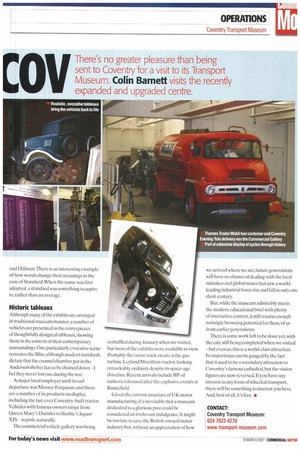ALL YOU NEED 1 C
Page 54

Page 55

If you've noticed an error in this article please click here to report it so we can fix it.
There's no greater pleasure than being sent to Coventry for a visit to its Transport Museum. Colin Barnett visits the recently expanded and upgraded centre.
Coventry has had some negative publicity lately, what with the closure of Peugeot's Ryton plant. But it's not all had news:the launch of the greatly enlarged and revamped Coventry Transport Museum is about as positive as it can get.
You may think that a local museum would be a small affair, but that would be to underestimate the significance of the city in the history of road transport. Just looking at the Roll of Honour with the names of nearly 600 Coventry automotive, motorcycle and cycle manufacturers puts the city's importance into perspective.
Anyone who visited the previous incarnation of the museum may be disappointed to hear that it is on the same site. However, what was once a pokey, back-street affair has now been turned into the focal point of the city's revitalised Millennium Place, providing the backdrop to the huge world clock and the Whittle Arch, a tribute to the jet-engine pioneer. Floor space at the museum has expanded to more than 11,500m2, and visitor numbers are approaching 300,000 a year.
The Coventry transport story really starts with arguably the most significant single vehicle in history,JK Starley's Rover Safety Bicycle of 1885, which provided the basic design for the machine ridden by millions worldwide today.
In 1896, the Daimler Motor Company began Britain's first motor manufacturing company in the city. By the end of the 20th century, Coventry had been home to 136 car and commercial vehicle manufacturers, coachbuilders and major component suppliers, along with 111 motorcycle manufacturers and 271 cycle makers.
Student achievements
Even if whole vehicle manufacturing in the city today has shrunk to just Jaguar and London Taxis International, Coventry University's automotive design department provides graduates to the worldwide industry, with recent output including the Ford Ka and Mercedes-Benz A-Class.The university has a own display area in the museum, showcasing the work of current students and encouraging future generations. Probably the highest-profile success in recent years has been the ThrustSSC supersonic land-speed record holder, largely the work of a consortium of Coventry engineering companies.The vehicle is on permanent display at the museum, as is its Thrust2 predecessor.
It's the vehicle displays, though, that will provide the greatest interest to most visitors. The inventory currently stands at nearly 350 motor vehicles and 200 bicycles, arranged in a series of themed galleries. Some cover specific periods of time, such as Boomtime Boomtown' highlighting the 1950s,1960s and 1970s, and another dedicated to the industry's declining years of the 1980s and 1990s—with soundtrack courtesy of The Specials' Ghost Town. Bicycles, motorcycles and commercials all get their own dedicated galleries.
Every corner turned brings back memories, often of marques you'd forgotten existed. Allard and Alvis, Eagle and Emms. Lanchester and Lea-Francis are just a few of the names from the grave. Many more are harder to forget, such as Jaguar,Triumph and Hillman.There is an interesting example of how words change their meanings in the case of Sta ndard. When the name was first adopted, a standard was something to aspire to, rather than an average.
Historic tableaux Although many of the exhibits are arranged in traditional museum manner,a number of vehicles are presented as the centrepieces of thoughtfully designed tableaux,showing them in the context of their contemporary surroundings One particularly evocative scene recreates the Blitz, although modern standards dictate that the enamel chamber pot in the Anderson shelter has to be chained down — I bet they never lost one during the war.
A major local employer until its sad departure was Massey-Ferguson, and there are a number of ILS products on display, including the last-ever Coventry-built tractor. Vehicles with famous owners range from Queen Mary's Daimler to Barbie's Jaguar XJS —in pink, naturally.
The commercial vehicle gallery was being reshuffled during January when we visited, but most of the exhibits were available to view. Probably the rarest truck on site is the gasturbine Leyland Marathon tractor, looking remarkably ordinary despite its space-age driveline. Recent arrivals include BP oil tankers, rehoused after the explosive events at Buncefield.
Given the current structure of UK motor manufacturing, it's inevitable that a museum dedicated to a glorious past could he considered an irrelevant indulgence. It might be too late to save the British-owned motor industry but, without an appreciation of how we arrived where we are, future generations will have no chance of dealing with the local mistakes and global issues that saw a worldleading industrial force rise and fall in only one short century.
But, while the museum admirably meets the modern educational brief with plenty of interactive content, it still retains enough nostalgic browsing potential for those of us from earlier generations.
There is some work left to be done yet, with the cafe still being completed when we visited — but even so. this is a world-class attraction. Its importance can be gauged by the fact that it used to be a secondary attraction to Coventry's famous cathedral, but the visitor figures are now reversed. If you have any interest in any form of wheeled transport, there will be something to interest you here. And, best of all, it's free. • CONTACT: Coventry Transport Museum: 024 7623 4270 www.transport-museum.com






















































































































































































